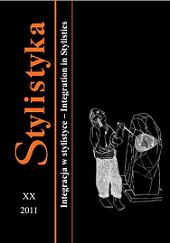O semiotycznej i intersemiotycznej roli tematu glownego. Od syntezy dziejow narodu polskiego do malarstwa realistycznego i nowoczesnego
ABOUT A SEMIOTIC AND INTER-SEMIOTIC FUNCTION OF GLOBAL TOPIC. FROM THE SYNTHESIS OF POLISH NATIONAL HISTORY TO REALISTIC AND MODERN PAINTING
Author(s): Maciej CzerwińskiSubject(s): Language and Literature Studies
Published by: Uniwersytet Opolski
Keywords: SEMIOTICS; SEMIOTICS OF CULTURE; HISTORICAL TEXT; PAINTING; IMAGE; VERBAL CODES; VISUAL CODES
Summary/Abstract: In the article the problem of semiosis of the global topic in verbal and visual texts is taken into consideration. In the first section a theoretical framework is introduced, in the second verbal text (i.e. the genre of the synthesis of Polish national history) is elaborated, in the third the similar discussion on visual ‘texts’ is conducted, while in the fourth section final remarks are provided with additional suggestions concerning further investigations. The opening remarks concern the very idea of the topic in verbal texts, notably in historical texts (the operational term final – taken from semiotic works of Boris Uspienski – is introduced). The final – interrelated with the global topic and genre – organizes the whole historical narration and establishes its cohesion; their overwhelming presence enables grasping the very act of data interpretation. Every event or historical figure conceptualized in a historical narration (for instance the Prussian Homage in 1525 or Polish king Sigismund) receives its own meaning only insofar as it maintains its constant relation with the global topic expressed by the title (top-down and bottom-up mechanisms). There are some similarities that the title and global topic possess in the acts of interpretation of painting, notably realistic representations of historical events. For example a piece of Jan Matejko entitled Hołd Pruski (Prussian Homage) imposes on an observer a set of connotative features deeply rooted in the Polish imaginery encoded in language and structured by the national narration. This particular example opens up a discussion about the function of the verbal title and visual ‘text’ in pieces of Giorgione, René Magritte, Kazimierz Malewicz, Marek Rostworowski. The analysis is not finished; it only sketches a very general problem of interrelation of verbal and visual codes that could be analyzed within the field of semiotics and semiotics of culture.
Journal: Stylistyka
- Issue Year: 2011
- Issue No: XX
- Page Range: 213-232
- Page Count: 20
- Language: Polish

